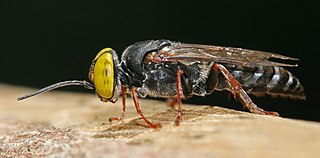
The Crabronidae are a large paraphyletic group of wasps, including nearly all of the species formerly comprising the now-defunct superfamily Sphecoidea. It collectively includes well over 200 genera, containing well over 9000 species. Crabronids were originally a part of Sphecidae, but the latter name is now restricted to a separate family based on what was once the subfamily Sphecinae. Several of the subfamilies of Crabronidae are often treated as families in their own right, as is true of the most recent phylogenies.
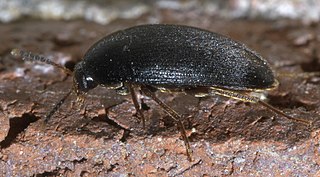
Tetratomidae is a small family of beetles sometimes called polypore fungus beetles. The family consists of several genera, most of which used to be in the family Melandryidae. Tetratomidae can be found worldwide.
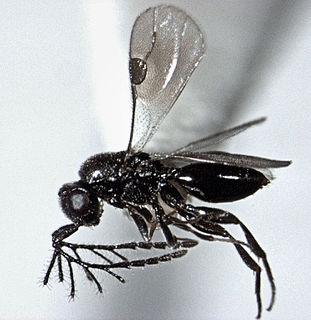
The Megaspilidae are a small hymenopteran family with 13 genera in two subfamilies, and some 450 known species, with a great many species still undescribed. It is a poorly known group as a whole, though most are believed to be parasitoids, and a few hyperparasitoids. Many are found in the soil, and of these, a number are wingless.

Myopsocidae is a family of mouse-like barklice, belonging to the infraorder Psocetae of the order Psocoptera. This family is closely related to Psocidae, with which it shares similar wing-venation, but from which it is distinguished by three-segmented tarsi.

Lachesillidae is a family of Psocoptera, or fateful barklice, belonging to the suborder Psocomorpha. Members of the family are characterised by a rounded, free areola postica in their wings. Males have diverse sclerotized genitalic structures. The family includes more than 400 species, most of them in the genus Lachesilla.
Paramyiolia is a genus of tephritid or fruit flies in the family Tephritidae.

The Ropalomeridae are a family of acalyptrate flies.
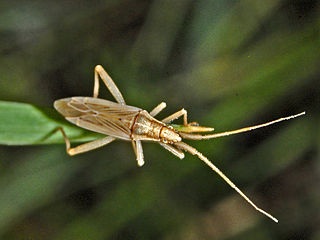
Stenodema is a genus of plant bugs in the family Miridae. There are about nine described species in Stenodema.
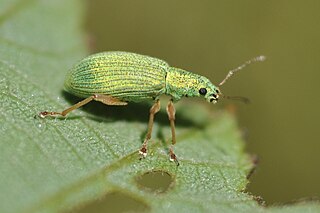
Polydrusus impressifrons, known generally as the pale green weevil or leaf weevil, is a species of broad-nosed weevil in the beetle family Curculionidae. It is found in North America & South Asia
Paraidemona is a genus of spur-throated grasshoppers in the family Acrididae. There are about nine described species in Paraidemona.

Eccritotarsini is a tribe of plant bugs in the family Miridae. There are about 14 genera and at least 40 described species in Eccritotarsini.
Glyptoscelis juniperi is a species of leaf beetle. It is found in North America.
Trigonoscuta cruzi is a species of broad-nosed weevil in the beetle family Curculionidae. It is found in North America.
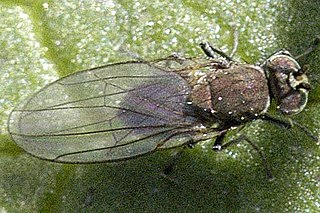
Hydrelliinae is a subfamily of shore flies in the family Ephydridae. There are about 10 genera and at least 130 described species in Hydrelliinae.

Pentaria is a genus of false flower beetles in the family Scraptiidae. There are about nine described species in Pentaria.
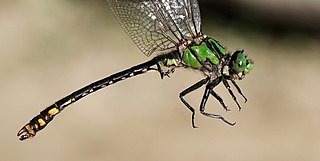
Ophiogomphus mainensis, the Maine snaketail, is a species of clubtail in the family of dragonflies known as Gomphidae. It is found in North America.
Smaragdina militaris is a species of case-bearing leaf beetle in the family Chrysomelidae. It is found in North America.
Crocidema is a genus of broad-nosed weevils in the beetle family Curculionidae. There are about six described species in Crocidema.

Nomiinae is a subfamily of sweat bees in the family Halictidae. There are about 11 genera and at least 550 described species in Nomiinae.
Trypoxylon lactitarse is a species of square-headed wasp in the family Crabronidae. It is found in Central America, North America, and South America. These are fairly common harmless black wasps that build muddy elongate nests on the external walls of houses and low-story apartments. Their characteristic nests resemble pan-flutes in shape, and are provisioned with spiders captured and paralysed by the mother wasp. It lays an egg within each elongate nest cell amongst the invalid spiders, from which a larva will hatch and slowly consume all spiders as food. This species apparently undergoes four larval moults until completing their development as pupae inside a black cocoon.














